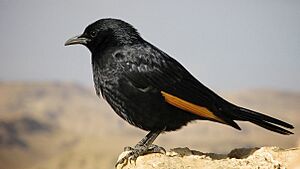Tristram's starling facts for kids
Quick facts for kids Tristram's starling |
|
|---|---|
 |
|
| at Masada, Israel | |
| Conservation status | |
| Scientific classification | |
| Genus: |
Onychognathus
|
| Species: |
tristramii
|
The Tristram's starling (Onychognathus tristramii) is a cool bird from the Middle East. People also call it the Dead Sea starling. It's a type of starling bird. This bird is special because it's the only one of its kind (genus Onychognathus) that mostly lives outside of Africa. It got its name from Reverend Henry Baker Tristram, who was a nature collector.
Contents
Where Tristram's Starlings Live
These birds live in deserts. You can find them in countries like Israel, Jordan, and parts of Egypt. They also live in western Saudi Arabia, Yemen, and Oman.
They mostly build their nests on rocky cliffs. But these birds are also starting to live closer to people. They find food in towns and villages. This has helped them spread further north recently.
What Tristram's Starlings Look Like
Tristram's starlings are about 25 centimeters (10 inches) long. This includes their long tail, which is about 9 cm (3.5 inches). Their wings can spread out to 44–45 cm (17–18 inches). They weigh between 100 and 140 grams (3.5–5 ounces).
Male starlings are shiny black with bright orange patches on their outer wings. These orange spots are easy to see when they fly. Their beaks and legs are black. Female and young birds look similar but are not as shiny. Their heads are a bit grayish.
How Tristram's Starlings Survive in the Desert
Starlings usually come from warm, tropical places. But the Tristram's starling is great at living in the desert. It doesn't lose much water from its body. It also produces less heat than you might expect for a bird its size.
Their dark feathers might help them in the desert winter. Even when it's cold, the sun can be very strong. The dark feathers help them soak up the sun's warmth.
What Tristram's Starlings Eat
Tristram's starlings eat many different things. They are omnivores. This means they eat both plants and animals. They enjoy fruits and small creatures without backbones. These include insects like beetles, flies, butterflies, and bees. They also eat small snails.
Sometimes, you can see them cleaning Nubian ibex (a type of wild goat) and farm animals. They pick off parasites from these animals.
These birds don't usually migrate (travel far away). But they do fly long distances each day compared to other birds that stay in one place. This makes them important for spreading seeds. They help new fruit plants grow in the desert. They also often look for food scraps in places where people live.
Tristram's Starling Reproduction
Tristram's starlings have their babies in the spring and early summer. They build their nests in holes found in rocky cliffs. They also use spaces in city buildings.
A male and female bird stay together as a pair. The male tries to impress the female by bringing her insects and small twigs. The female lays 2 to 4 eggs. The eggs are blue with brown spots.
Only the female bird sits on the eggs to keep them warm. But both parents help feed the baby birds once they hatch. The young birds leave the nest about a month after they are born. Some pairs will have a second group of babies later in the season. They use the same nest again.
How Tristram's Starlings Behave
Tristram's starlings are very social birds. They are also quite noisy! Their call sounds a bit like a wolf whistle.
When it's not breeding season, these starlings live in groups. These groups can have anywhere from ten to a few hundred birds. Even when they join a big group, the male and female pairs stay together all year round.
Gallery
-
Tristram's starling on a Nubian ibex in Sde Boker, Israel







